A simplification of your two circuits may illustrate why your first cannot work, while your second can work. The simplification involves eliminating L's and C's leaving antenna, diode and audio transducer:
simulate this circuit – Schematic created using CircuitLab
I have replaced your 8 ohm speaker with a 2K ohm audio transducer, like high-impedance headphones. This substitution results in far more audio. In both cases, motion of the speaker or headphone's cone results from current flowing through a coil in the presence of a permanent magnet.
The leftmost simple circuit is equivalent to your first series circuit. It produces no audio for SPKR1 because there is a very weak return path for audio currents back to the antenna - through the antenna's capacitance-to-ground. Any audio signal produced will appear between the diode's anode and ground - the antenna gets the audio, not SPKR1.
The rightmost simple circuit is equivalent to your second "parallel" circuit. Here, the antenna signal appears across both the diode and SPKR2. Positive peaks of the radio signal cause the diode to conduct. The diode shunts these antenna currents directly to ground, so that speaker current is small. Negative peaks of the radio signal are not shunted to ground by the diode, but pass through SPKR2. These pulses of current produce audio in SPKR2.
In your second circuit, the audio current loop passes through L1 (1uH), SPKR1
(8 ohm) and D1 (1N4148). The reactance of L1 is miniscule for audio, compared to the reactance of the 8-ohm speaker, so audio is delivered to SPKR1.
In your first circuit, the audio current loop includes ground, SPKR1, diode, C1 (a 1uf variable!), L1 (1 uH), Antenna, and a tiny capacitor between antenna and ground. Any current in this loop is pretty much killed by the extremely high impedance of this tiny capacitor.
I have built both versions of my "simplified" crystal radio, and can verify that the leftmost produces no audio, compared to the rightmost, which produced painful audio from the nearest AM source.
One must be
very careful about using linear circuit analysis in this case, because the diode is an important
non-linear element. The diode becomes a signal source for audio rather than the antenna, complicating analysis considerably. In this case, a SPICE
TRANSIENT ANALYSIS gives a more complete picture, so long as equivalent circuit is properly presented. A SPICE analysis of these simplified series & parallel circuits follows.
First - what is the equivalent circuit of the antenna? For AM broadcast band, let us assume a thin wire Marconi-type antenna, extending vertically for 30 feet above a perfect ground. Choose a simple mid-point on the broadcast band - 1 MHz. At 1 MHz., this is a short non-resonant antenna whose equivalent circuit is a resistor and capacitor.
ARRL ANTENNA BOOK gives formula for short wire antennas:
$$
R_{s}=273 \times 10^{-8} ({lf}) ^2
$$
where l=inches wire length, f=frequency (Mhz)
$$
C_{s}={{17 L} \over {[ln{24 L \over D}-1]} \times {[1- {fL \over 234}^2]}}
$$
where L=wire length above ground (ft), D=wire diameter, inches.
For this example, I calculate antenna equivalent Rs=0.354 ohms, Cs=59pf
Into ORCAD SPICE, a crude signal voltage source simulates an AM-modulated carrier wave of 1 MHz. It's modulation isn't sinusoidal, but adequately illustrates the different behaviour of the series circuit (on the right side this time, and the parallel circuit (on the left side this time). Amplitude is very large, (10v peak for each source). A proper model for the speaker is quite complex, and has been reduced to a 1K resistor:
A transient analysis is run with max time-step of 10ns., so that all the 1MHz pulses are properly stepped through. Since speaker current is the motive source for moving its cone, current through the 1K resistor is shown:
The parallel diode-SPKR2 yields the expected large current, which will be audible. The series diode-SPKR1 yields very small current, which is very much attenuated - the missing audio appears across the 59 pf capacitor of the antenna equivalent (Cs).
